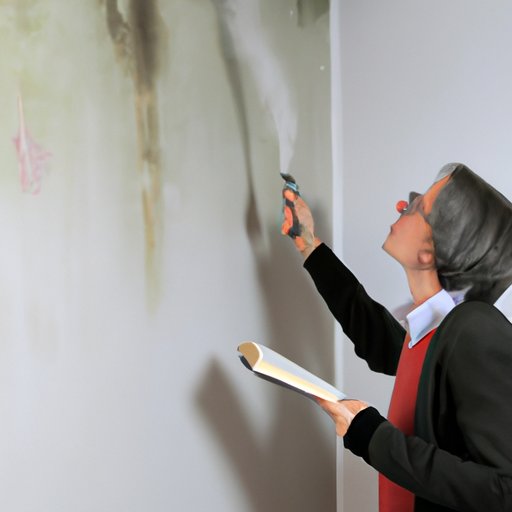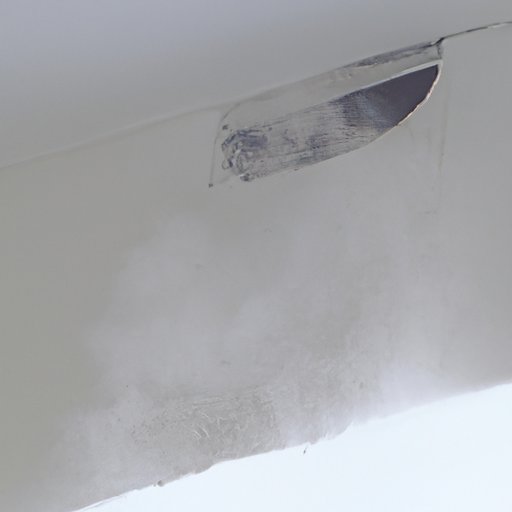Introduction
The smell of fresh paint can be both comforting and exciting, but it’s important to understand the potential risks associated with painting indoors. One of the most common questions people have is whether paint fumes can travel through walls. While the answer isn’t always clear, there are a few factors to consider when determining the potential risks of paint fumes traveling through walls.

Examining the Risks of Paint Fumes Traveling Through Walls
When it comes to understanding the potential risks associated with paint fumes, it’s important to first consider the type of paint being used. According to the Environmental Protection Agency (EPA), some paints contain volatile organic compounds (VOCs) which can be hazardous to your health if inhaled. VOCs are chemicals that evaporate easily at room temperature, and can cause a variety of symptoms including headaches, dizziness, and nausea.
Additionally, the materials used in the construction of the walls can affect the spread of paint fumes. For instance, drywall is more porous than plaster or brick, meaning fumes may be more likely to travel through it. Furthermore, the age of the building can play a role in the spread of paint fumes. Older buildings tend to have fewer insulation materials, making them more susceptible to the spread of paint fumes.
Another factor to consider is the impact of paint fumes on air quality. According to the EPA, indoor air pollution can be two to five times higher than outdoor air pollution, and paint fumes can contribute to this problem. An air quality test can help determine if paint fumes are affecting the air inside your home.
How to Contain Paint Fumes Within a Room
Fortunately, there are strategies you can use to contain paint fumes within a single room. The most important step is to ensure proper ventilation in the area where you’re painting. This means opening windows and doors to allow fresh air to enter the space and pushing out the fumes. Utilizing fans and open windows can also help create a cross-breeze, which can further reduce the risk of fumes spreading through the building.
In addition to natural ventilation, using a paint booth or enclosure can help contain the fumes. These products are designed to keep paint fumes from escaping into other areas of the house, and they come in a variety of sizes and styles. Many are portable and easy to set up, making them ideal for any painting project.
How to Safely Paint Without Impacting Others
It’s also important to take safety precautions when painting indoors. Wearing proper protective gear such as a respirator mask, eye protection, and gloves can help reduce the risk of exposure to harmful chemicals. Additionally, choosing low-VOC paints can help minimize the amount of fumes released into the air.
If possible, it’s also a good idea to schedule painting projects during times when fewer people are home. This will help reduce the risk of exposing family members or roommates to potentially dangerous fumes.

The Dangers of Inhaling Paint Fumes Through Walls
If you suspect that paint fumes are entering other rooms of your home, it’s important to recognize the symptoms of paint fume exposure. These include headaches, dizziness, nausea, and irritation of the eyes, nose, and throat. If you experience any of these symptoms after painting, it’s important to investigate the source of the fumes and take steps to reduce the risk of exposure.
It’s also important to seek medical attention if you suspect you’ve been exposed to paint fumes over a long period of time. Long-term exposure to paint fumes can lead to serious health problems, so it’s important to get checked out if you’re experiencing any persistent symptoms.
Investigating the Effects of Paint Fumes on Air Quality
If you’re concerned about the effects of paint fumes on air quality, it’s a good idea to test the air in your home. This can help you identify any potential sources of paint fumes and determine the best way to reduce their impact on air quality. Additionally, it’s important to evaluate the impact of paint fumes on indoor air quality, as well as learn about local regulations regarding paint fumes.

Strategies for Preventing Paint Fumes from Entering Other Rooms
There are also several strategies you can use to prevent paint fumes from entering other rooms. Sealing doors and windows with plastic sheeting or caulking can help reduce the risk of fumes escaping into other areas of the house. Additionally, utilizing negative air pressure and installing air filters can help remove paint fumes from the air and keep them from entering other rooms.
Conclusion
Overall, it’s important to understand the potential risks associated with paint fumes traveling through walls. Taking safety precautions such as wearing protective gear and utilizing proper ventilation can help reduce the risk of exposure to fumes. Additionally, utilizing strategies such as sealing doors and windows and installing air filters can help prevent paint fumes from entering other rooms. By educating yourself on the potential risks and taking the necessary steps to reduce them, you can ensure that your painting projects are done safely and effectively.
(Note: Is this article not meeting your expectations? Do you have knowledge or insights to share? Unlock new opportunities and expand your reach by joining our authors team. Click Registration to join us and share your expertise with our readers.)
